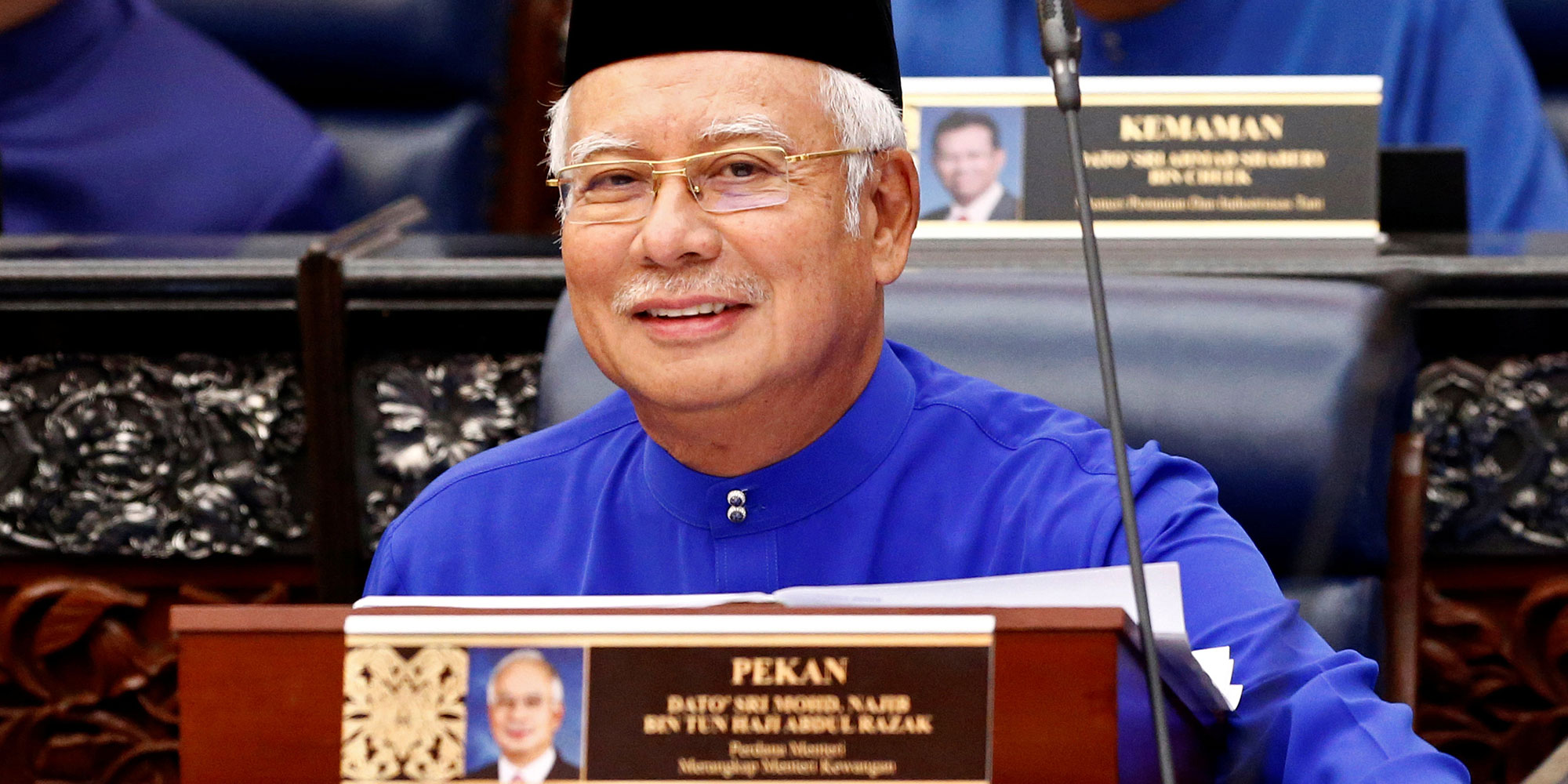Malaysia Announces Budget Draft, Looks to Provide Generous Amount of Development for Infrastructure and Regional Areas Amidst the Country’s Favourable Economy
|
During 16–31 October, Indonesia estimated its growth rate for 2018 at 5.4% YoY within the budget that it recently established for the next financial year, with the government predicting that the country’s economic growth will accelerate gradually in comparison to 2017. |
|
In addition, the budget draft proposed to the Parliament of Malaysia for the next financial year estimated the country’s growth at 5.0–5.5% YoY, which remains at a high level despite minor deceleration. Another important activity took place in the southern region of the Philippines, where a five-month-long conflict between a militant group operating under the name “Islamic State” (IS) and the country’s military came to a close. |
|
Indonesia: Established Budget for Next Year with Growth Estimated at 5.4% Indonesia’s balance of trade for September was announced at USD 1.76 billion on 16 October, marking the highest balance on a monthly basis since December 2011, with the surplus also rising substantially by 37% YoY. This balance has continued to remain in the black, with the exception of July 2017. 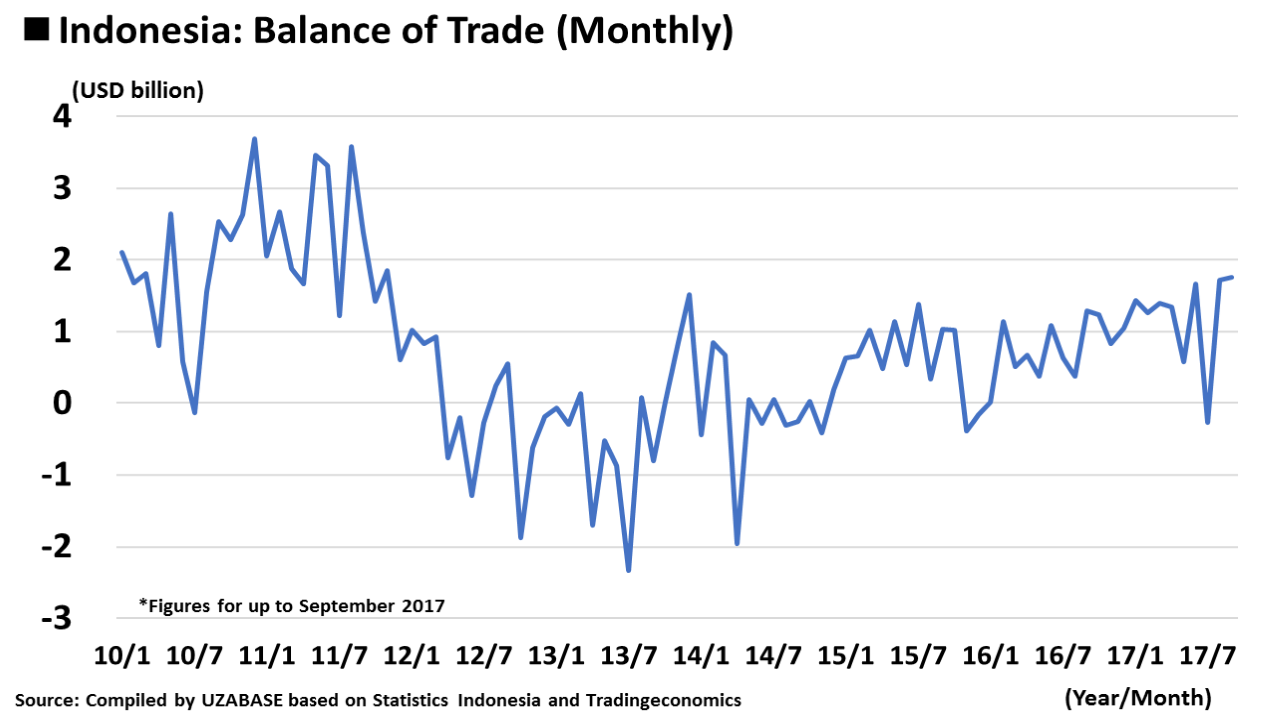 In the non-petroleum and gas segment, the country registered a positive balance at USD 2.26 billion, but this was supported by mineral fuels such as coal, and there have been no changes in the country’s dependence on primary products in its export structure. On 25 October, the country formulated its budget for FY2018, within which estimates were set for economic growth at 5.4% YoY, inflation rate at 3.5% YoY, and fiscal deficit target at 2.19% of the country’s GDP. The annual revenue estimate was set at IDR 1,894.7 trillion (approximately USD 140.2 billion, up by 5.0% from the 2017 budget revision), while that for annual expenditure was set at IDR 2,220.7 trillion (approximately USD 164.3 billion). In the budget draft proposed on 16 August, President Joko Widodo emphasised the need for countermeasures against poverty and the reduction of inequality, as well as increased expenditures on education, health, and the establishment of infrastructure. He also noted three principles that should be strictly adhered to, namely 1) increasing the ratio of revenue from taxes and streamlining the management of natural resources in order to increase the country’s annual revenue, 2) enhancing the quality of government spending, and 3) dissolving the country’s deficit and adjusting its debt ratio in order to secure financial sustainability. Regarding forecasts for Indonesia’s economic growth in 2018, the country’s Institute for Development of Economics & Finance (INDEF) noted that it may be difficult to reach the 5.4% YoY target. As a reason for this forecast, INDEF noted that the amount of investment planned for regional elections throughout the country in the first half of that year will have a negative effect. For elections in Indonesia, political parties increase economic activity by creating items like printouts and t-shirts in large volumes, as well as having their candidates and campaign members travel. On the other hand, political matters become increasingly unclear in such times, leading to a strong tendency of corporations postponing investments until after elections. Furthermore, INDEF noted that even with efforts to make improvements in the second half of 2018 (July to December), investments will once again be widely suppressed during the presidential election in 2019, estimating that a large turn towards favourable economic growth will be difficult. 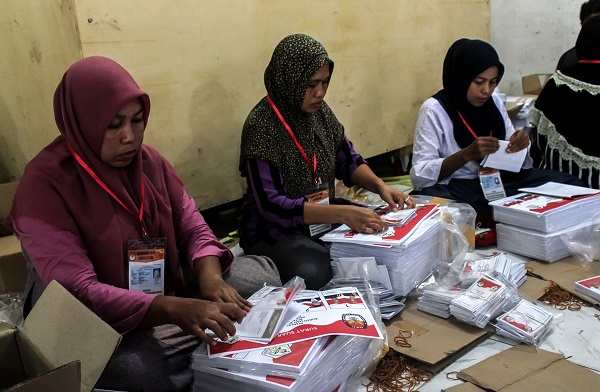 Scene showing preparations for the local elections that took place in Lhokseumawe in the Aceh Special District in 2017. Photo by Fachrul Reza/NurPhoto/GettyImages On 19 October, Indonesia’s central bank, Bank Indonesia (BI), held its Board of Governor’s Meeting, where it decided to keep the current policy interest rate of 4.25%. At the meeting, it also estimated that the country’s actual GDP growth rate for 3Q will accelerate from the 5.01% YoY recorded for 2Q. BI also pointed out that Indonesia’s growth will be underpinned by increased consumption along with the rising public expenditures, such as bonuses for national government workers and government financial aids provided to citizens who are in poverty, as well as increased investment centred on the construction sector. Moreover, BI noted that the country’s growth rate for the entire year in 2017 may exceed the initial estimate of 5.0–5.4% YoY, and maintained the original estimate for 2018 at 5.1–5.5% YoY. 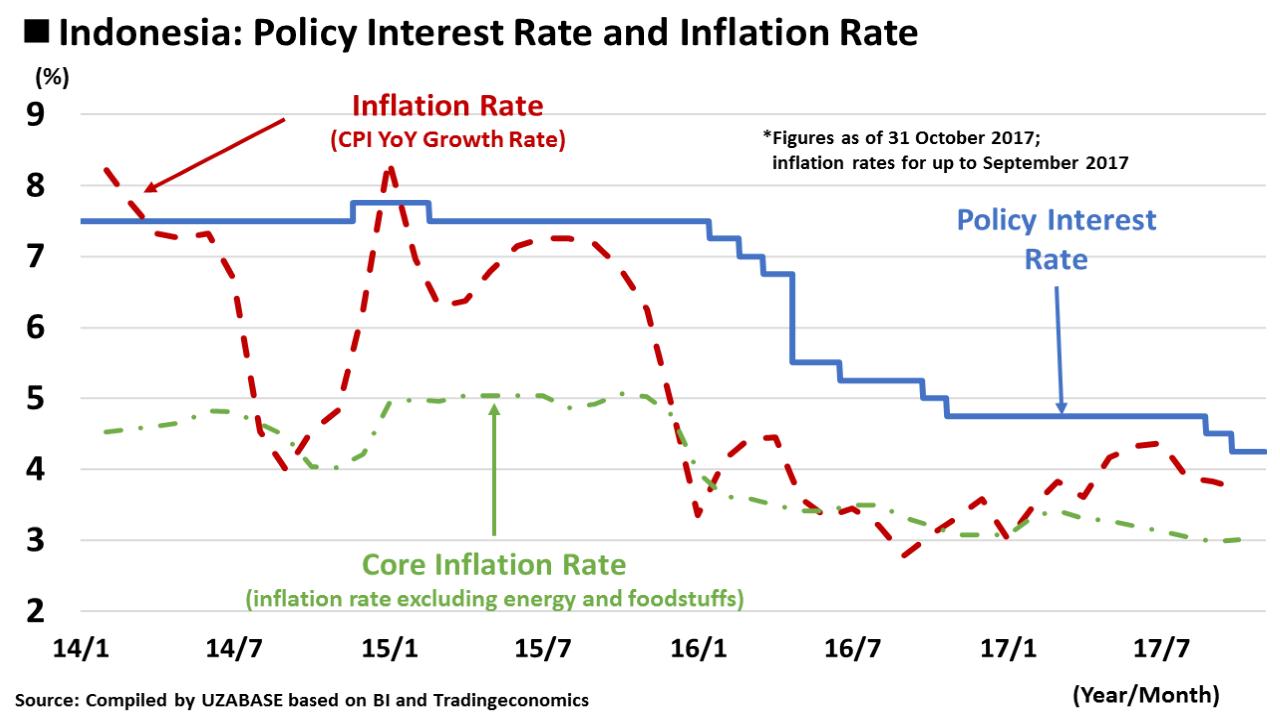 |
|
Thailand: Will Consumption Recover After the Period of Mourning? On 29 October, the funeral ceremony for Thailand’s former monarch, King Bhumibol the Great, ended, as did the period of mourning. During that period, Thailand’s citizens largely tended to refrain from lavish spending, with expectations that consumption will turn upwards going forward. The next few months will act as a test to see whether the decrease in consumption up to this point was a result of the mourning, or whether it is an issue with the structure of Thailand’s economy. 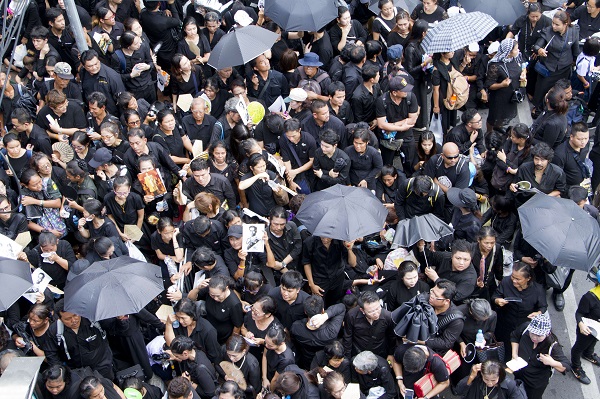 Thailand’s citizens crowd together to participate in the final parting with King Bhumibol the Great. Photo by Fachrul Reza/NurPhoto/GettyImages Unit sales for new automobiles in Thailand in September stood at 77,592 units, growing remarkably by 21.9% YoY, and marking the second-highest month for unit automobile sales in 2017 after March (84,801 units). The first half of 2013, when this amount surpassed the 10,000-unit level, was special in that subsidies were provided for purchasing eco-cars, with the actual conditions of the automobile market reflected in the time after the effects of those subsidies wore off. The present state of unit automobile sales appears to be showing signs of increasing after bottoming out. 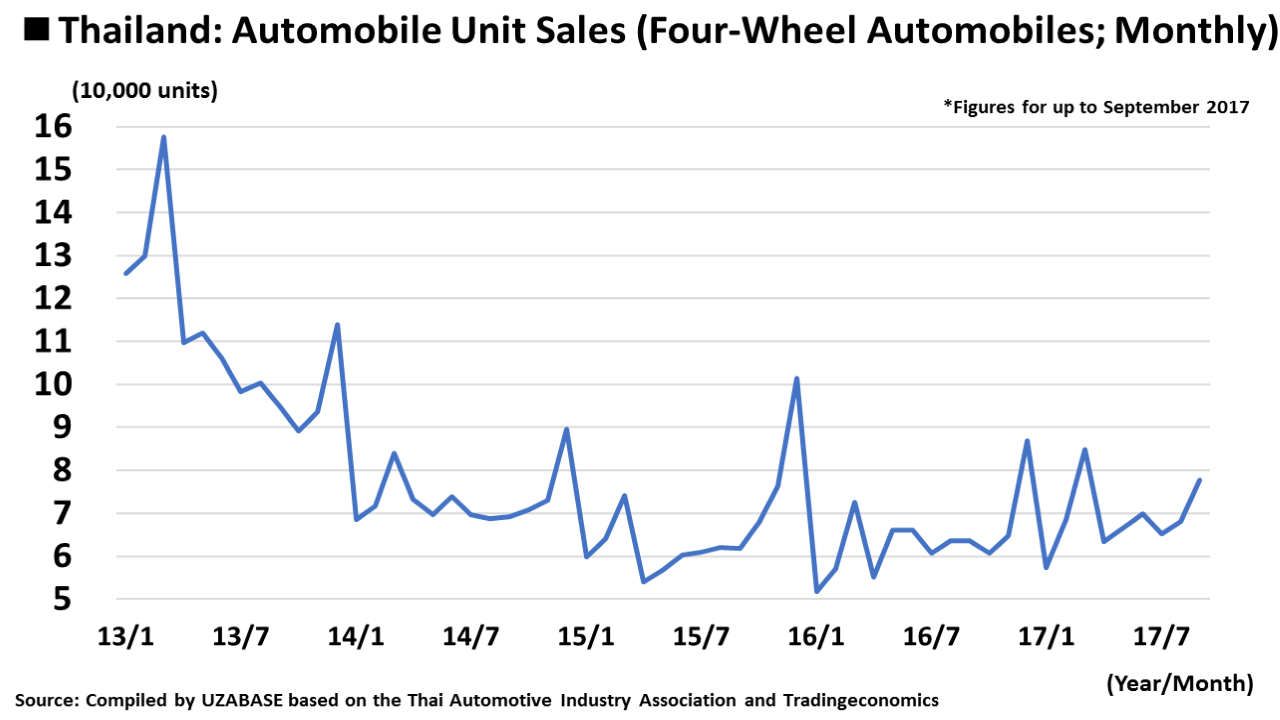 Thailand’s Investment Plan for Government and Civil Affairs 2017–22 was approved at the cabinet meeting held on 24 October. The plan outlined a total investment amount of THB 1.62 trillion (approximately USD 48.75 billion), and included large-scale projects such as the construction of high-speed railways connecting each of the country’s major airports (Suvarnabhumi, Don Mueang, and U-Tapao) and the expansion of Laem Chabang Port, which is used for the shipments of automobiles, amongst other items. Furthermore, on 27 October, a meeting was held between Deputy Prime Minister of Thailand Somkid Jatusripitak (also the head of the economy) and the Vice Premier of the People’s Republic of China Zhang Gaoli. The governments of both countries convened with the aim of strengthening the two countries’ economic cooperation in the regions of the Pearl River Delta, centred on China’s southern region of Guangdong Province, and going forward, they will begin adjusting the details of this cooperation through senior-level official meetings. Moreover, the Thai government proposed that Thailand be utilised as an entry point for CLMV (Cambodia, Laos, Myanmar, and Vietnam), and that the country will strengthen the relationship between the Eastern Economic Corridor and the Pearl River Delta as part of China’s Belt and Road Initiative. On 17 October, the Thai Bond Market Association expressed concerns over the amount of long-term corporate bonds held by individual investors, which totalled THB 782.7 billion (approximately USD 23.6 billion) as of end-June 2017, representing 33% of the country’s total value of issued bonds. The Association claimed that this amount was excessive, with a high risk of default on debts. As such, trends in Thailand’s financial sector, represented by the bond market, will be key points to watch for the time being. |
|
Malaysia: Budget Increase Amidst a Backdrop of Favourable Economic Conditions On 27 October, Prime Minister of Malaysia Najib Razak, who is also the country’s Minister of Finance, announced the budget draft for FY2018. Within this draft, the country’s economic growth target for that year was set at 5.0–5.5% YoY, with the budget for annual expenditure at MYR 280.25 billion (approximately USD 66.10 billion), which is an increase by about 7.5% from the initial budget draft for FY2017 at MYR 260.80 billion (approximately USD 61.51 billion). This budget draft will be completed after undergoing review by the Parliament of Malaysia. Regarding the budget draft, although there is criticism over refraining from holding elections until early 2018, with the country’s favourable economic growth in 2017, a budget increase that is focused on infrastructure construction and promoting development in regional areas such as the states of Sabah and Sarawak is an appropriate one. Moreover, as a theme for the budget draft, after the “Vision 2020” programme, which aims to make Malaysia an advanced nation by 2020, the draft stipulated progress towards the “2050 National Transformation” programme, which looks to achieve an economy with much higher added value, as well as the strengthening of Malaysia as a “digital economy”. 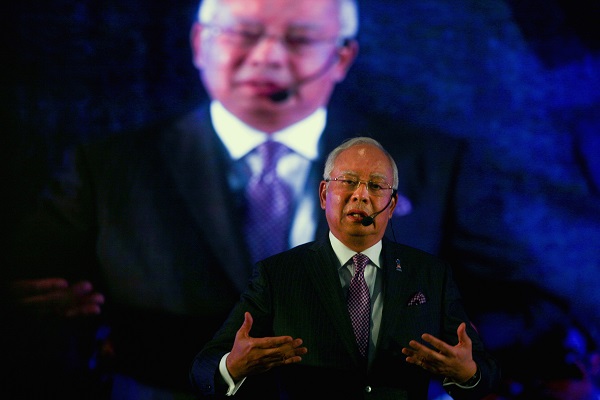 Prime Minister Najib Razak gives a speech at the “2050 National Transformation Forum” held in September 2017. Photo by Mohd Samsul Mohd Said/GettyImages On 27 October, Malaysia’s Ministry of Finance announced estimates for the country’s 2017 economic growth rate (actual GDP growth rate) at 5.2–5.7% YoY and for the growth rate in 2018 at 5.0–5.5% YoY in its Economic Report for 2017–18. As the Ministry’s initial estimate for 2017 was 4.3–4.8%, the new estimates mark a substantial upward revision by 0.9 percentage points. In comparison to other emerging economies where the GDP per capita is at the USD 10,000 level, Malaysia is expected to continue exhibiting a high level of growth. Crude oil prices are recovering after bottoming out, and both manufacturing and service sectors are showing firm growth. |
|
The Philippines: Armed Conflict in Marawi on the Island of Mindanao Comes to a Close On 23 October, the Secretary of National Defense of the Philippines, Delfin Lorenzana, announced that the conflict between a militant group under the name of IS, which had appeared in late May, and the Philippine military that had been taking place in the country’s southern region in the city of Marawi on the island of Mindanao had come to a close. The number of casualties over the conflict’s approximate five-month period (up to 22 October) amounted to 919 IS members, 165 military and law enforcement personnel, and 47 civilians, and the 1,780 people that had been taken hostage were released. There had been concerns that the conflict would spread to the surrounding areas, and that terror groups would diffuse, but the fact that the combat in Marawi, which is the source of such groups, has ended is promising. However, as the number of domestic refugees that resulted from this conflict has been in the hundreds of thousands, there has no doubt been a huge scar left on the local economy and society. In addition to the Moro Islamic Liberation Front, there are numerous militant groups that are active in the Mindanao region. In order to suppress such groups, the Philippine government has poured in various resources, including budgets and personnel. The country’s economy has exhibited favourable conditions in recent years, but the budget that should have been used for infrastructure development, education, and reducing poverty has gone into the domestic armed conflict. If these conditions cannot be improved, it will be difficult for the Philippines to realise a long-term, official rise in the economy. |
|
Vietnam: Move Towards Regulations for Virtual Currencies Like the Bitcoin Vietnam usually releases a large amount of macroeconomic data at the end of the month, but attention should be paid to the revisions made to these data after the announcement made a few days prior to the end of the respective month. Vietnam’s industrial production was up by 17.0% YoY in October, while retail sales were also up by 12.7% YoY, both of which maintained high-level growth. On 30 October, the country’s foreign direct investment (FDI; approval basis for new and additional investment) for January through October 2017 was announced at USD 28.24 billion, marking favourable growth at 37.4% YoY. The country providing the most investment is South Korea, which has continued to remain on top since 2016. Furthermore, the number of visitor arrivals to the country from abroad surpassed 1 million in October, with the number for the year already having exceeded 10 million. In addition, based on the macroeconomic data provided by Vietnam, the country is currently maintaining favourable economic conditions. The country’s central bank, the State Bank of Vietnam, announced penal regulations on the distribution and use of virtual currencies like the Bitcoin. Violators will be fined a maximum of VND 200 million (approximately USD 8,800).  Photo by Dan Kitwood/Getty Images This notification suggests that Vietnam may lack trust for its own currency, the Vietnamese dong. In Vietnam, there is a strong tendency for people to possess gold or US dollars as a portfolio for protecting assets, but virtual currencies may provide a safe haven in future. Gold is physically rare, and US dollars are controlled by foreign currency exchange regulations, but virtual currencies can be exchanged freely as no rules have been established yet. The regulations that were recently announced reveal that there are likely increasing concerns of such a case within State Bank of Vietnam. |
|
Singapore: Residential Property Prices Bottomed Out The final figures announced for Singapore’s residential property prices for 2Q showed growth by 0.7% YoY, which is 0.2 percentage points above the temporary figure of 0.5% YoY that was announced on 2 October. While this marked a positive turn from the -0.1% YoY recorded for 1Q, the growth is at a low level. After Singapore’s residential property prices rose substantially over 2011–13, the range of increase contracted. Prices appear to have hit the bottom over the past few months, but a few more months are required to get a clear picture. 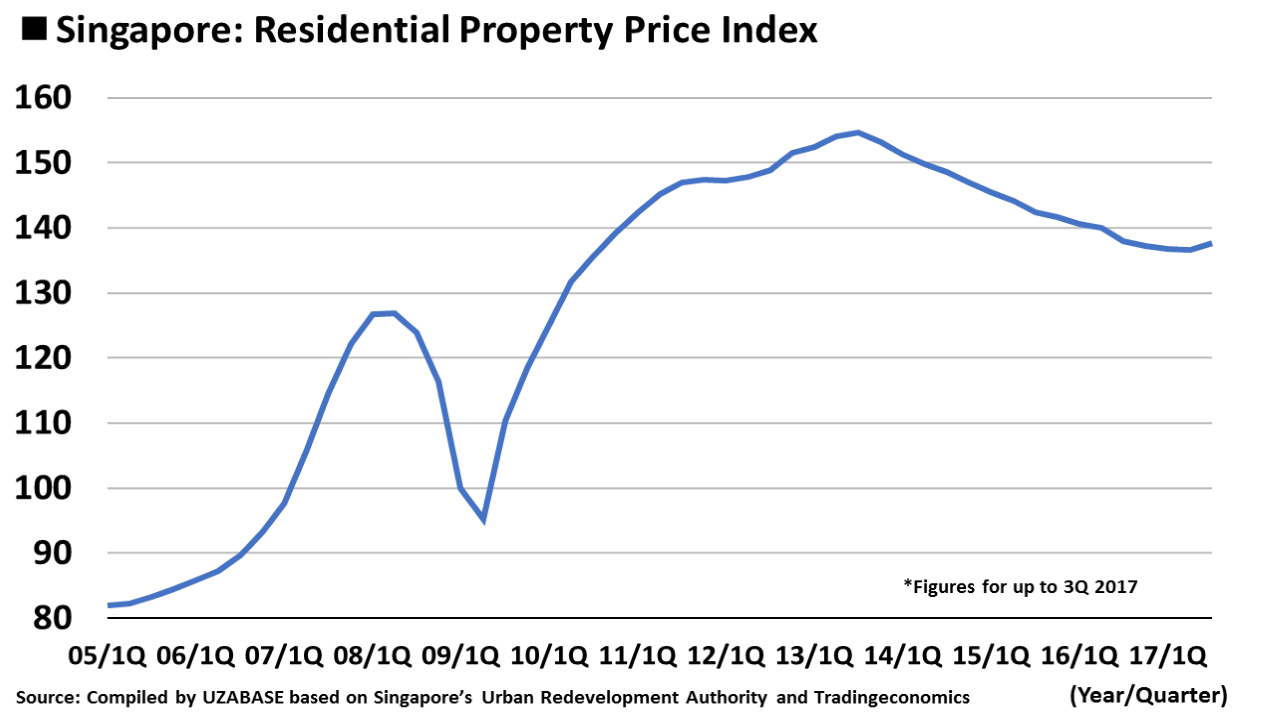 |
|
Key Focus in the Next Report The next report will cover the period from 1–15 November, with the most important statistic to focus on being Indonesia’s GDP for 3Q. Thailand, Malaysia, and the Philippines will also hold monetary policy meetings during this time. Moreover, the Business Confidence Index (BCI) and Consumer Confidence Index (CCI) for Thailand, which has been exhibiting gradual economic growth, and the Nikkei Manufacturing Purchasing Managers’ Indices (Nikkei PMIs) for each country that are to be announced at the beginning of the month will require attention, as these figures provide insight into economic trends.
|
